I apologize if this has been asked before. I'm new to python and programming in general so please point me in the right direction if it has been asked. I'm using python 3.7.
I have a 2D numpy array where each element is a stored function. I want to add the functions in each column to get a 1D array where the elements of the 1D array are a single function. I'm not sure why the np.sum() function doesn't work to do this. I get a 1D array but the functions are only from the first column of the "npwavefxns" array.
i.e.
[[X00,X01,...,X0n]
[X10, X11,...,X1n]
...
[Xn0,Xn1,...[Xnn]]
-> [[X00+X10+...+Xn0, X01+X11+...+Xn1, X0n+X1n+...+Xnn]]
The np.sum() function seems to work for integers, so I'm not sure why it doesn't work when the elements are a function. A sample of my code is given below. If this code works correctly I suspect to get these 4 plots when "4" basis functions are used.
from scipy import mat, matrix, integrate
from scipy.integrate import quad
import numpy as np
from numpy import linalg as la
import os
from matplotlib import pyplot as plt
# Defining variables and functions
MP=float(9.10938356e-31) #mass of electron in kg
WL=float(1e-10) #length of well in meters
CON=float(1.60218e-19) #constant height in joules
Hb = float(1.054571726e-34) #reduced planck's constant in J s
NB=int(input("Number of basis functions ")) #define number of basis sets to be used
#####Potential energy of initial state#####
PE=[]
for j in range(1,NB+1):
alist=[]
for k in range(1,NB+1):
F1=integrate.quad(lambda x:((2/WL)*np.sin((k*np.pi*x)/WL)*
((-CON)*np.sin(np.pi*x/WL))*np.sin((j*np.pi*x)/WL)),0,WL)[0]
if F1 < -1e-25:
F1=F1
elif F1 > 1e-25:
F1=F1
else:
F1=0
alist.append(F1)
PE.append(alist)
PEarray=np.asarray(PE)
#####Kinetic Energy of initial state#####
KE=[]
for j in range(1,NB+1):
blist=[]
for k in range(1,NB+1):
F2=integrate.quad(lambda x:(((((Hb**2)*(j**2)*(np.pi**2))/(MP*(WL**3)))*
((np.sin(j*np.pi*x/WL))*(np.sin(k*np.pi*x/WL))))),0,WL)[0]
if F2 < -1e-25:
F2=F2
elif F2 > 1e-25:
F2=F2
else:
F2=0
blist.append(F2)
KE.append(blist)
KEarray=np.asarray(KE)
#####Adding PE and KE to give the full hamiltonian of the initial state#####
#####Then convert the list to a numpy array#####
sum=[0]*NB
for i in range(NB):
sum[i]=[0]*NB
for y in range(len(PEarray)):
for z in range(len(PEarray[0])):
sum[y][z]=PEarray[y][z]+KEarray[y][z]
npsum=np.asarray(sum)
EVal, EVec=la.eigh(npsum)
wavefxns=[]
for j in range(1,NB+1):
clist=[]
for k in range(1,NB+1):
F3 = (lambda x: ((EVec.item(k-1, j-1))*
(np.sin((((k+1)*np.pi)/WL)*x))))
clist.append(F3)
wavefxns.append(clist)
npwavefxns=np.asarray(wavefxns)
EQS=[]
for j in range(0,NB):
F4=np.sum(npwavefxns.item(j))
EQS.append(F4)
npEQS=np.asarray(EQS)
for j in range(0,NB):
wfxn1=(lambda x: ((npEQS.item(j))(x)))
plt.xlabel("Box length")
plt.ylabel("energy")
x = np.linspace(0,WL,500)
plt.plot(x, wfxn1(x), '--m')
plt.show()




